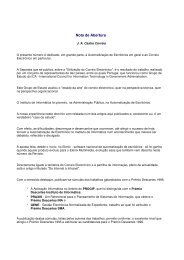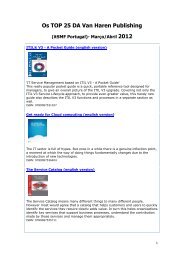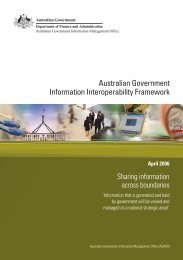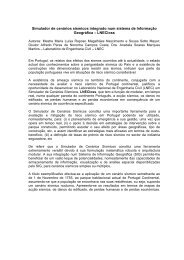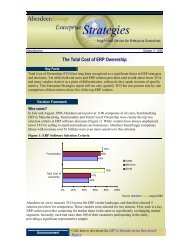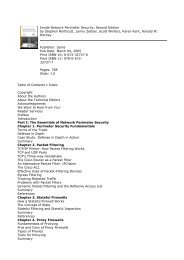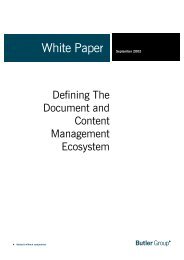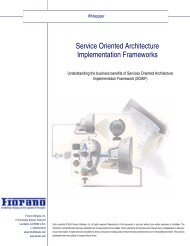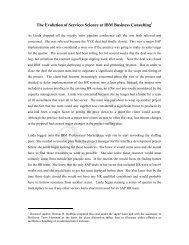OECD Peer Review of E-Government in Denmark - ePractice.eu
OECD Peer Review of E-Government in Denmark - ePractice.eu
OECD Peer Review of E-Government in Denmark - ePractice.eu
You also want an ePaper? Increase the reach of your titles
YUMPU automatically turns print PDFs into web optimized ePapers that Google loves.
7. As a means <strong>of</strong> combat<strong>in</strong>g the “sow/harvest” problem that is seen to lead to sub-optimal levels <strong>of</strong><br />
multi-organisation e-government <strong>in</strong>itiatives, the <strong>Government</strong> should thoroughly assess the existence and nature <strong>of</strong><br />
this problem, and consider development <strong>of</strong> a commonly applicable model for f<strong>in</strong>anc<strong>in</strong>g e-government <strong>in</strong>itiatives.<br />
Such a model should cover the f<strong>in</strong>anc<strong>in</strong>g <strong>of</strong> all aspects <strong>of</strong> <strong>in</strong>itiatives, <strong>in</strong>clud<strong>in</strong>g: specification, tender<strong>in</strong>g,<br />
contract<strong>in</strong>g, system or application development, implementation and ma<strong>in</strong>tenance. It should also <strong>in</strong>clude<br />
mechanisms for proportional assessment and allocation <strong>of</strong> costs and benefits between participat<strong>in</strong>g organisations<br />
and/or levels <strong>of</strong> government.<br />
8. The digital divide is not a primary challenge or barrier to e-government <strong>in</strong> <strong>Denmark</strong>. However, the<br />
<strong>Government</strong> could consider whether, <strong>in</strong> the longer-term, wider e-government policy options and improved<br />
e-government costs, benefits and achievements would result from replac<strong>in</strong>g the current approach towards the<br />
clos<strong>in</strong>g the digital divide <strong>in</strong> <strong>Denmark</strong> with a more active one.<br />
4. Plann<strong>in</strong>g and Leadership<br />
The e-government vision and strategy<br />
<strong>Denmark</strong> has been successful <strong>in</strong> develop<strong>in</strong>g a common vision for e-government, and <strong>in</strong><br />
translat<strong>in</strong>g it <strong>in</strong>to a well-def<strong>in</strong>ed strategy that is known across government and provides an important<br />
driver for e-government implementation. Three key features <strong>of</strong> the strategy are: 1) its relationship to<br />
wider government policies; 2) the <strong>in</strong>volvement <strong>of</strong> all tiers <strong>of</strong> government <strong>in</strong> the governance,<br />
development, and implementation <strong>of</strong> the strategy; and 3) support <strong>of</strong> the strategy by a partnership<br />
between two strong m<strong>in</strong>istries with complementary roles and expertise.<br />
The e-government strategy was <strong>in</strong>troduced <strong>in</strong> 2002, revised <strong>in</strong> 2004, and will run to the end <strong>of</strong><br />
2006. In 2003 a review <strong>of</strong> the strategy identified a number <strong>of</strong> challenges and obstacles faced by<br />
e-government. Address<strong>in</strong>g these has <strong>in</strong>volved a shift from “s<strong>of</strong>t” to “strong” co-ord<strong>in</strong>ation as the<br />
overall approach to implementation <strong>of</strong> the strategy. This shift has led to: 1) more pressure be<strong>in</strong>g placed<br />
on organisations to align themselves with the strategy; 2) more robust evaluation <strong>of</strong> proposals for<br />
e-government projects; 3) State m<strong>in</strong>istries be<strong>in</strong>g required to develop ICT strategies encompass<strong>in</strong>g all<br />
their departments, agencies and other sub-bodies; and 4) contemplation <strong>of</strong> <strong>in</strong>creased centralisation <strong>of</strong><br />
some aspects <strong>of</strong> e-government. Overall, implementation <strong>of</strong> the strategy has moved away from<br />
exhortation and example towards be<strong>in</strong>g more action- and results-oriented. Of note is the fact that a<br />
more active co-ord<strong>in</strong>at<strong>in</strong>g and centralis<strong>in</strong>g role is be<strong>in</strong>g played by organisations at the centre <strong>of</strong><br />
government represents someth<strong>in</strong>g <strong>of</strong> a departure from traditions and current conventions <strong>of</strong> Danish<br />
public management, which rely upon decentralisation and consensus.<br />
The vision <strong>of</strong> the <strong>Government</strong>’s current e-government strategy is that “Digitalisation must<br />
contribute to the creation <strong>of</strong> an efficient and coherent public sector with a high quality <strong>of</strong> service, with<br />
citizens and bus<strong>in</strong>esses at the centre”. To do this, the strategy def<strong>in</strong>es five e-government goals to be<br />
achieved by the end <strong>of</strong> 2006, and sets out measures <strong>of</strong> their achievement. Of particular note is the goal<br />
<strong>of</strong> 75% <strong>of</strong> e-government <strong>in</strong>itiatives releas<strong>in</strong>g resources for other uses.<br />
<strong>Government</strong> organisations are generally happy with the way the e-government strategy has been<br />
developed and the goals it establishes, and have responded well to it. The strategy conta<strong>in</strong>s<br />
well-def<strong>in</strong>ed goals that have been developed with the wide <strong>in</strong>volvement <strong>of</strong> organisations from all<br />
levels <strong>of</strong> government. These have acted as an important guide for the e-government efforts <strong>of</strong><br />
<strong>in</strong>dividual organisations. However, they can f<strong>in</strong>d it difficult to evaluate whether their achievements are<br />
satisfactory. The majority <strong>of</strong> the measures set out <strong>in</strong> the strategy rely upon survey data collected by<br />
Statistics <strong>Denmark</strong>. This reliance on organisations’ self-reported progress aga<strong>in</strong>st the goals <strong>of</strong> the<br />
strategy does not appear adequate for form<strong>in</strong>g a robust and <strong>in</strong>dependently validated view <strong>of</strong> whether<br />
they are be<strong>in</strong>g adequately achieved.<br />
13



